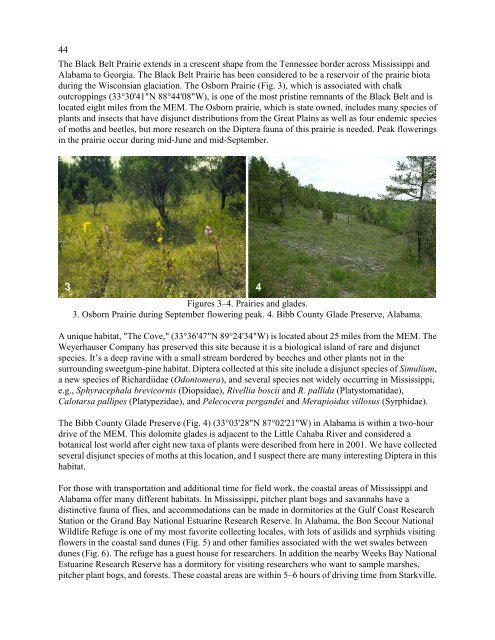Fly Times Issue 48, April 2012 - North American Dipterists Society
Fly Times Issue 48, April 2012 - North American Dipterists Society
Fly Times Issue 48, April 2012 - North American Dipterists Society
Create successful ePaper yourself
Turn your PDF publications into a flip-book with our unique Google optimized e-Paper software.
44<br />
The Black Belt Prairie extends in a crescent shape from the Tennessee border across Mississippi and<br />
Alabama to Georgia. The Black Belt Prairie has been considered to be a reservoir of the prairie biota<br />
during the Wisconsian glaciation. The Osborn Prairie (Fig. 3), which is associated with chalk<br />
outcroppings (33°30'41"N 88°44'08"W), is one of the most pristine remnants of the Black Belt and is<br />
located eight miles from the MEM. The Osborn prairie, which is state owned, includes many species of<br />
plants and insects that have disjunct distributions from the Great Plains as well as four endemic species<br />
of moths and beetles, but more research on the Diptera fauna of this prairie is needed. Peak flowerings<br />
in the prairie occur during mid-June and mid-September.<br />
Figures 3–4. Prairies and glades.<br />
3. Osborn Prairie during September flowering peak. 4. Bibb County Glade Preserve, Alabama.<br />
A unique habitat, "The Cove," (33°36'47"N 89°24'34"W) is located about 25 miles from the MEM. The<br />
Weyerhauser Company has preserved this site because it is a biological island of rare and disjunct<br />
species. It’s a deep ravine with a small stream bordered by beeches and other plants not in the<br />
surrounding sweetgum-pine habitat. Diptera collected at this site include a disjunct species of Simulium,<br />
a new species of Richardiidae (Odontomera), and several species not widely occurring in Mississippi,<br />
e.g., Sphyracephala brevicornis (Diopsidae), Rivellia boscii and R. pallida (Platystomatidae),<br />
Calotarsa pallipes (Platypezidae), and Pelecocera pergandei and Merapioidus villosus (Syrphidae).<br />
The Bibb County Glade Preserve (Fig. 4) (33°03'28"N 87°02'21"W) in Alabama is within a two-hour<br />
drive of the MEM. This dolomite glades is adjacent to the Little Cahaba River and considered a<br />
botanical lost world after eight new taxa of plants were described from here in 2001. We have collected<br />
several disjunct species of moths at this location, and I suspect there are many interesting Diptera in this<br />
habitat.<br />
For those with transportation and additional time for field work, the coastal areas of Mississippi and<br />
Alabama offer many different habitats. In Mississippi, pitcher plant bogs and savannahs have a<br />
distinctive fauna of flies, and accommodations can be made in dormitories at the Gulf Coast Research<br />
Station or the Grand Bay National Estuarine Research Reserve. In Alabama, the Bon Secour National<br />
Wildlife Refuge is one of my most favorite collecting locales, with lots of asilids and syrphids visiting<br />
flowers in the coastal sand dunes (Fig. 5) and other families associated with the wet swales between<br />
dunes (Fig. 6). The refuge has a guest house for researchers. In addition the nearby Weeks Bay National<br />
Estuarine Research Reserve has a dormitory for visiting researchers who want to sample marshes,<br />
pitcher plant bogs, and forests. These coastal areas are within 5–6 hours of driving time from Starkville.
















